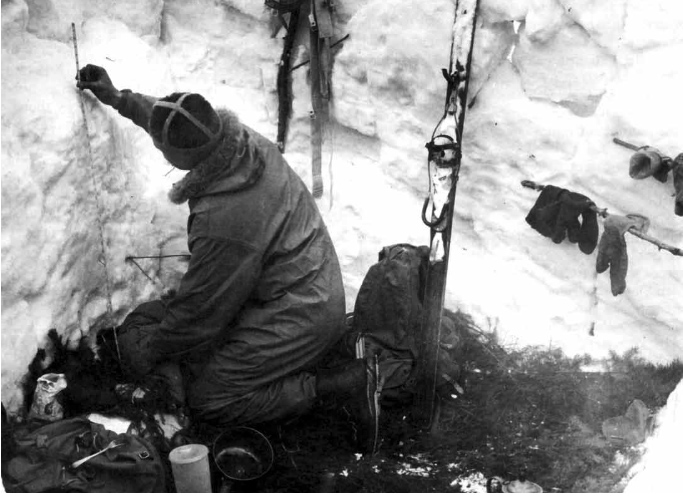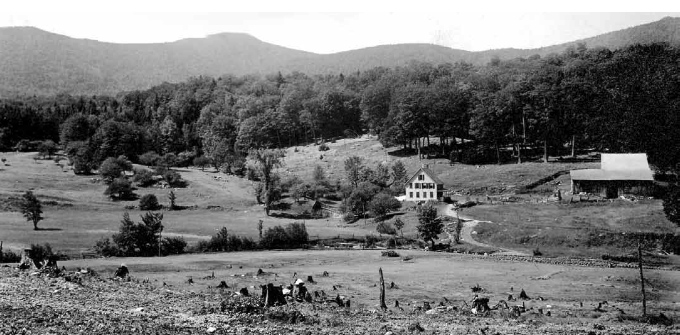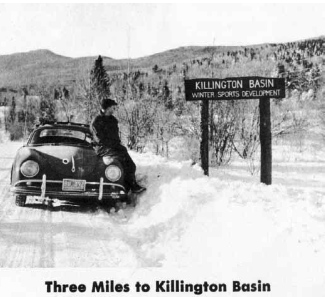By Karen D. Lorentz
Last week, I wrote that State Forester Perry Merrill initially envisioned developing Killington Mountain for skiing to benefit the state. However, it wasn’t until he met the young Preston Smith that he found a passionate skier who would share his enthusiasm for a mountain few were aware existed.
Although he checked out the area and caught up to Merrill’s vision, Smith didn’t have the financial wherewithal to develop Killington and was turned down when he went looking for investors. A fortuitous meeting in Hartford, Connecticut., paved the way for a partnership with Joe Sargent, another passionate skier who shared his vision.
In addition to bringing a financial background and the ability to see that “the all-important financial means and strategy” were necessary, Joe Sargent was able to introduce Smith to potential investors.

Pres Smith camped on the mountain with Walter Morrison (who took this photo) during the winter of 1956.
In October 1955, Sargent agreed to talk to friends in Hartford and gave Smith the names of potential investors.
One of them was Joseph Van Vleck, III., who had been a classmate at Yale and worked in the investment department of the Travelers Insurance Company. He accompanied Smith and Sargent on a November exploration of the mountain. They walked the mountain repeatedly and began to talk and plan. Some “weighty conclusions” were scribbled on the back of an envelope, including the idea of paying Smith $70 a week or about 80 cents an hour for his work. (Actually, he wasn’t paid until much later.)
With Van Vleck agreeing to invest in the project, Joe and Mary T. Sargent, Pres and Sue Smith, and Van Vleck each put up $250 for one share of stock. With that $1,250 investment, they registered the Sherburne Corporation with the State of Vermont on April 6, 1956. Franklin S. Billings of Woodstock was the clerk of the newly formed corporation.
Other early key support
On April 19, 1956, Robert W. Mitchell, chairman of the Rutland Industrial Development Committee and owner/publisher of the Rutland Herald, Vermont’s oldest continuously operating daily newspaper, signed a pledge to subscribe to stock. Mitchell was among several early investors who, believing that the ski area would be good for the region, actively promoted Killington and showed personal support by promising to invest in the fledgling Sherburne Corporation.
In the early planning stages, Smith and Sargent felt it would be beneficial to have a third person actively involved in organizing the project. Sargent had known Walter N. Morrison at Yale, and when he returned east after running his own lumber business out on the West Coast, Sargent interested him in Killington. In February 1956, Morrison became an active participant. Like Sargent, he made weekend trips to Vermont, putting his mountaineering background and practical experience to work. Morrison played a significant role in early mountain development, from making snow measurements to cutting trees and contributing to layout, construction, and financing decisions.
Morrison was born in California and raised in Connecticut. He attended Andover Academy and graduated from Yale as a literary major in 1950. After military service as a platoon leader in Korea, he went to Oregon, where he started a sawmill and logging business, which he ran successfully for several years before returning east to get married.
From his outdoor business, he gained experience with tractors, chainsaws, and employees—a practical background that would come in handy when building a ski area.
During his sawmill days, Morrison also met a businessman who intrigued him with details of the corporate world. On his return to Hartford, he became a securities analyst with Hartford Steam Boiler Inspection and Insurance Company, inspectors and insurers of powerful and expensive machinery.
The cerebral side of Morrison was involved with an indoors, analytical stocks and bonds business, while the creative outdoors persona found the tangible Killington venture much to his liking.
A tall, affable, and fun-loving person, Morrison recalled that he and Smith had a similar interest in motorcycles and skiing and had “hit it off right away.” Smith and Morrison hiked into the mountains in the winter of 1956, camping out in the snow, exploring the area, and taking more snow measurements. Morrison recalled (in our 1980s interviews) that from the beginning, he thought it “was a good mountain.”
He also helped lay out the work road to the mountain and became a shareholder and the sixth member of the board of directors in June 1957. On August 20, 1957, at a special Sherburne Corporation board of directors meeting in Connecticut, Sargent, Smith, and Morrison were appointed to the executive committee.
It turned out to be a wise choice for the three of them to function well as a decision-making team.
Snags and progress
Due to snags with getting the access road built, funds with which the corporation could do business were limited to those invested by the promoters of the project, the Smiths, Sargents, Van Vleck, and Morrison. Since April 1956, those assets had quadrupled to $4,800. By selling his two shares of stock in Mt. Snow, Sargent had $4,000 to invest in Sherburne Corporation stock, and he laughingly recalled, “That made me Mr. Money-bags for the project.”
However, after buying the Bates farmhouse and accompanying acreage in November 1956, the cash on hand in January 1957 was $791.66.
However, the escrow account grew to $20,000 as Smith continued to visit people, including an enclave of skiers in New Haven, where he raised another $10,000.
Their investing was critical because it enabled an escrow account of $30,000 to be placed with the State of Vermont to satisfy a stipulation of the proposed Killington Road highway bill before the 1957 Legislature — that the Sherburne Corporation had the money to develop the mountain once the road was in.
The terms of the escrow account provided that invested money would be held until the lease was obtained, which required a road. This is a Catch-22 we’ll explore in a later article when we see how perseverance was another key to Killington becoming the Beast.
Next week we’ll meet the women who were key players in Killington’s debut and success at a time when ski areas were largely “a man’s world.”
Comments and insights are welcome: email [email protected] to share thoughts about skiing in the 1950s and especially of any women you are aware of who helped develop new areas.

The Bates Farm as it appeared in 1905. The farmhouse is now Killington Valley Real Estate and the Wobbly Barn has replaced the original barn on the right.




